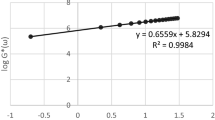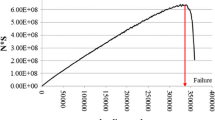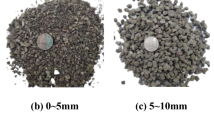Abstract
Rutting and fatigue are two major pavement distresses which affect both structural and functional performances of the flexible pavement. Linear amplitude sweep (LAS) and Multiple stress creep and recovery (MSCR) are two advanced methods to examine fatigue and rutting performance of asphalt binders respectively. The present study aims at examining the effect of ageing (short term and long term) and modification (polymer and warm mix) on the performance of asphalt binders. Both LAS and MSCR tests were conducted at different temperatures, stress/strain levels, and ageing conditions. Stress is a parameter that influences the performance of asphalt binder significantly so stress susceptibility was also evaluated for all the binders at different temperatures and ageing conditions. From the test results, it was found that ageing improves the stress susceptibility of the asphalt binders with respect to rutting parameters on the other hand ageing deteriorated the stress susceptibility concerning fatigue parameters. The applicability of different asphalt binders at different temperature and traffic conditions was also examined and it was found that most of the binders failed to fulfill the criteria at the temperatures which were well below their high-temperature performance grades. This highlighted the need to revise the Superpave criteria.









Similar content being viewed by others
References
Read, J., & Whiteoak, D. (2003). The shell bitumen handbook. Thomas Telford Services Ltd.
Saboo, N. (2016). “Performance characterization of polymer modified asphalt binders and mixes” Ph.D. thesis, Indian Institute of Technology, Roorkee, India.
Singh, B., Saboo, N., & Kumar, P. (2017). Effect of short-term aging on creep and recovery response of asphalt binders. Journal of Transportation Engineering, Part B: Pavements, 143(4), 04017017.
Lu, X., Isacsson, U., & Ekblad, J. (1999). Rheological properties of SEBS, EVA and EBA polymer modified bitumens. Materials and Structures, 32(2), 131–139.
Sengoz, B., & Isikyakar, G. (2008). Evaluation of the properties and microstructure of SBS and EVA polymer modified bitumen. Construction and Building Materials, 22(9), 1897–1905.
Airey, G. D. (1997). “Rheological characteristics of polymer modified and aged bitumens” Ph.D. thesis, University of Nottingham.
Isacsson, U. L. F., & Lu, X. (1999). Characterization of bitumens modified with SEBS, EVA and EBA polymers. Journal of Materials Science, 34(15), 3737–3745.
Cardone, F., Ferrotti, G., Frigio, F., & Canestrari, F. (2014). Influence of polymer modification on asphalt binder dynamic and steady flow viscosities. Construction and Building Materials, 71, 435–443.
Traxler, R. N. (1961). Relation between asphalt composition and hardening by volatilization and oxidation. Proc. Association of Asphalt Paving Technologists, 30, 359–377.
Curtis, C. W., Ensley, K., & Epps, J. (1993). “Fundamental properties of asphalt-aggregate interactions including adhesion and absorption” No SHRP-A-341. National Research Council.
Petersen, J., R. Robertson, J. Branthaver, P. Harnsberger, J. Duvall, S. Kim, D. Anderson, D. Christiansen, and H. Bahia. (1994). “Binder characterization and evaluation: Volume 1” Rep. No. SHRP-A-367. Strategic Highway Research Program, National Research Council, Washington, DC.
Zhang, J., Walubita, L. F., Faruk, A. N. M., Karki, P., & Simate, G. S. (2015). Use of the MSCR test to characterize the asphalt binder properties relative to HMA rutting performance—a laboratory study. Construction and Building Materials, 94, 218–227. https://doi.org/10.1016/j.conbuildmat.2015.06.044
Saboo, N., & Kumar, P. (2016). Analysis of different test methods for quantifying rutting susceptibility of asphalt binders. Journal of Materials in Civil Engineering. https://doi.org/10.1061/(ASCE)MT.1943-5533.0001553
Saboo, N., & Kumar, P. (2016). Performance characterization of polymer modified asphalt binders and mixes. Advances in Civil Engineering. https://doi.org/10.1155/2016/5938270
Sabouri, M., Mirzaiyan, D., & Moniri, A. (2018). Effectiveness of linear amplitude sweep (LAS) asphalt binder test in predicting asphalt mixtures fatigue performance. Construction and Building Materials, 171, 281–290. https://doi.org/10.1016/j.conbuildmat.2018.03.146
Singh, D., Girimath, S., & Ashish, P. K. (2019). Effect of recycled asphalt binder on high and intermediate temperature performance of polymer modified asphalt binder. International Journal of Pavement Research and Technology, 12, 486–496. https://doi.org/10.1007/s42947-019-0059-3
Kim, H. H., Lee, M. S., & Lee, S. J. (2019). Performance evaluation of polymer modified asphalt (PMA) binders containing ground tire rubber (GTR). International Journal of Pavement Research and Technology, 12, 215–222. https://doi.org/10.1007/s42947-019-0027-y
D’Angelo, J. A. (2009). The relationship of the MSCR test to rutting. Road Materials and Pavement Design, 10(sup1), 61–80.
DuBois, E., Mehta, Y., & Nolan, A. (2014). Correlation between multiple stress creep recovery (MSCR) results and polymer modification of binder. Construction and Building Materials, 65, 184–190.
Hintz, C., Velasquez, R., Johnson, C., & Bahia, H. (2011). Modification and validation of linear amplitude sweep test for binder fatigue specification. Transportation Research Record, 2207(1), 99–106.
Saboo, N., & Kumar, P. (2016). Analysis of different test methods for quantifying rutting susceptibility of asphalt binders. Journal of Materials in Civil Engineering, 28(7), 04016024.
Teymourpour, P., and Bahia, H. (2014). Linear amplitude sweep test: Binder grading specification and field validation. In Presentation on Binder Expert Task Group Meeting. Asphalt Research Consortium, Baton Rouge, LA, USA.
Asphalt Institute. (2020). US state binder specifications. http://www.asphaltinstitute.org/engineering/specification-databases/us-state-binder-specifications. Accessed 20 Mar 2021.
AASHTO M 332. (2014). Standard specification for performance-graded asphalt binder using multiple stress creep recovery (MSCR) test. American Association of State and Highway Transportation Officials.
Golalipour, A., Bahia, H. U., & Tabatabaee, H. A. (2017). Critical considerations toward better implementation of the multiple stress creep and recovery test. Journal of Materials in Civil Engineering, 29(5), 04016295.
Wasage, T. L. J., Stastna, J., & Zanzotto, L. (2011). Rheological analysis of multi-stress creep recovery (MSCR) test. International Journal of Pavement Engineering, 12(6), 561–568.
Zhou, Z., Gu, X., Jiang, J., Ni, F., & Jiang, Y. (2018). Nonrecoverable behavior of polymer modified and reclaimed asphalt pavement modified binder under different multiple stress creep recovery tests. Transportation Research Record, 2672(28), 324–336.
Jafari, M., Babazadeh, A., & Aflaki, S. (2015). Effects of stress levels on creep and recovery behavior of modified asphalt binders with the same continuous performance grades. Transportation Research Record, 2505(1), 15–23.
Liu, J., Liu, J., Zhu, A., & Saboundjian, S. (2020). Evaluation of multiple stress-creep recovery test on Alaskan asphalt binders. Journal of Materials in Civil Engineering, 32(10), 04020302.
Hintz, C., & Bahia, H. (2013). Simplification of linear amplitude sweep test and specification parameter. Transportation Research Record, 2370, 10–16.
Jafari, M., & Babazadeh, A. (2016). Evaluation of polyphosphoric acid-modified binders using multiple stress creep and recovery and linear amplitude sweep tests. Road Materials and Pavement Design, 17, 859–876. https://doi.org/10.1080/14680629.2015.1132631
Saboo, N., Kumar, R., Kumar, P., & Gupta, A. (2018). Ranking the rheological response of SBS-and EVA-modified bitumen using MSCR and LAS tests. Journal of Materials in Civil Engineering, 30(8), 04018165. https://doi.org/10.1061/(ASCE)MT.1943-5533.0002367
Singh, B., & Kumar, P. (2019). Effect of polymer modification on the ageing properties of asphalt binders: Chemical and morphological investigation. Construction and Building Materials, 205, 633–641.
ASTM D2872-12e1. (2012). Standard test method for effect of heat and air on a moving film of asphalt (Rolling Thin-Film Oven Test). ASTM International. https://doi.org/10.1520/D2872-12E01 West Conshohocken, PA.
ASTM D6521-18. (2018). Standard practice for accelerated aging of asphalt binder using a pressurized aging vessel (PAV). ASTM International. https://doi.org/10.1520/D6521-18 West Conshohocken, PA.
AASHTO TP 70. (2013). Standard method of test for multiple stress creep recovery (MSCR) test of asphalt binder using a dynamic shear rheometer (DSR). American Association of State and Highway Transportation Officials.
AASHTO TP 101-14. (2014). Standard method of test for estimating fatigue resistance of asphalt binders using the linear amplitude sweep. American Association of State Highway and Transportation Officials.
Nivitha, M. R., Prasad, E., & Krishnan, J. M. (2016). Ageing in modified bitumen using FTIR spectroscopy. International Journal of Pavement Engineering, 17(7), 565–577.
Singh, B., Saboo, N., & Kumar, P. (2017). Use of Fourier transform infrared spectroscopy to study ageing characteristics of asphalt binders. Petroleum science and technology, 35(16), 1648–1654.
Lu, X., & Isacsson, U. (2002). Effect of ageing on bitumen chemistry and rheology. Construction and Building materials, 16(1), 15–22.
Tauste, R., Moreno-Navarro, F., Sol-Sánchez, M., & Rubio-Gámez, M. C. (2018). Understanding the bitumen ageing phenomenon: A review. Construction and Building Materials, 192, 593–609.
Petersen, J. C. (2009). A review of the fundamentals of asphalt oxidation: chemical, physicochemical, physical property, and durability relationships. Transportation Research Circular, (E-C140), Washington: Transportation Research Board.
Cortes, C., Perez, A., Fermoso, J., Costa, A., Guisado, F., Esquena, J., & Potti, J. (2010). Envejecimiento fotooxidativo de betunes asfálticos. Comunicaciones libres de la V Jornada Nacional de ASEFMA.
Tarsi, G., Varveri, A., Lantieri, C., Scarpas, A., & Sangiorgi, C. (2018). Effects of different aging methods on chemical and rheological properties of bitumen. Journal of Materials in Civil Engineering, 30(3), 04018009.
Abbas, A. R., Papagiannakis, A. T., & Masad, E. A. (2004). Linear and nonlinear viscoelastic analysis of the microstructure of asphalt concretes. Journal of Materials in Civil Engineering, 16(2), 133–139.
Singh, B., Saboo, N., & Kumar, P. (2016). Modelling the complex modulus strain relationship of asphalt binders. Petroleum Science and Technology, 34(13), 1137–1144.
Pei, J., Fan, Z., Liu, H., Zhang, J., Li, R., & Li, Y. (2016). Nonlinear viscoelastic model for asphalt mixture subjected to repeated loading. Road Materials and Pavement Design, 17(4), 892–905.
Singh, B., & Kumar, P. (2020). Viscoelastic and morphological evaluation of aged polymer modified asphalt binders. International Journal of Civil Engineering, 18, 1077–1096. https://doi.org/10.1007/s40999-020-00517-4
IS:1203. (1978). Indian standard methods for testing tar and bituminous materials: determination of penetration. Bureau of Indian Standards (BIS), New Delhi, India.
IS:1205. (1978). Indian Standard methods for testing tar and bituminous materials: determination of softening point. Bureau of Indian Standards (BIS), New Delhi, India.
IS:1206. (1978). Indian standard methods for testing tar and bituminous materials: determination of viscosity: absolute viscosity. Bureau of Indian Standards (BIS), New Delhi, India.
ASTM-D7175. (2012). Standard test method for determining the rheological properties of asphalt binder using a dynamic shear rheometer. ASTM International, West Conshohocken, PA.
Author information
Authors and Affiliations
Corresponding author
Rights and permissions
About this article
Cite this article
Singh, B., Kumar, P. Rutting and Fatigue Performance of Aged Modified Asphalt Binders. Int. J. Pavement Res. Technol. 15, 789–802 (2022). https://doi.org/10.1007/s42947-021-00053-x
Received:
Revised:
Accepted:
Published:
Issue Date:
DOI: https://doi.org/10.1007/s42947-021-00053-x




